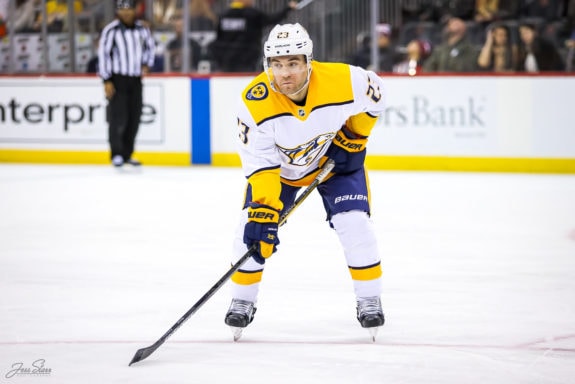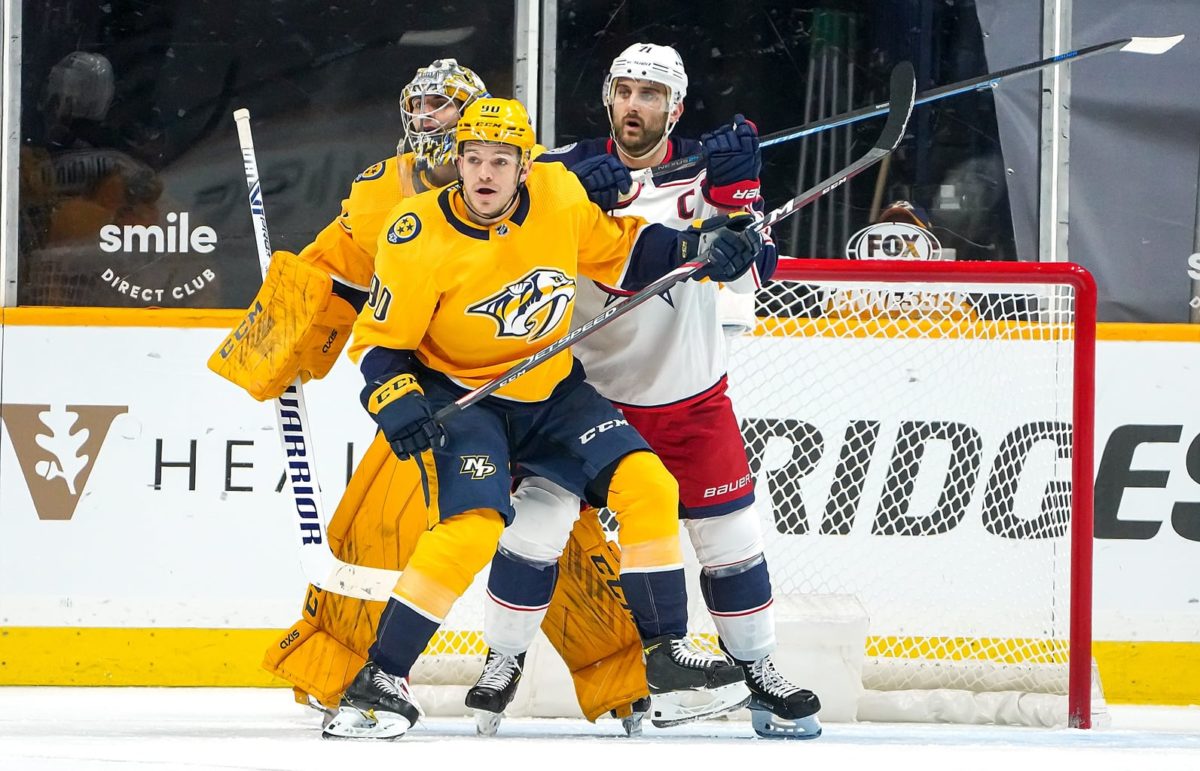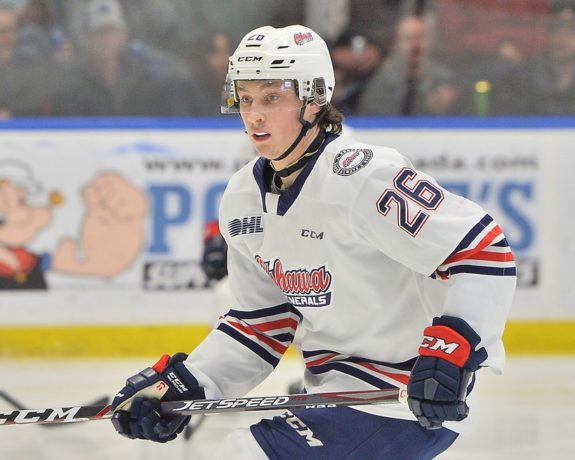David Poile is digging two words into the ground: competitive rebuild. He’s mentioned it more than most people would like to admit, but he has a vision, and he’s sticking to it. The dead period of the offseason is upon us, and although the Predators might be gearing up to make another move, we won’t know until a tweet from Elliotte Friedman pops up on our Twitter timelines.
With no moves in the immediate future, it seems perfectly reasonable to look at the lineup heading into next season and what I think would be the best way to optimize strength and speed without sacrificing defensive responsibility. For this exercise, I will construct forward lines and defense pairs and explain very briefly why I think they would be effective. Of course, things could change after publishing this article and the start of the season, but speculation is always fun.
Forward Lines
Line 1: Forsberg- Johansen-Duchene
It is a fireable offense if head coach John Hynes doesn’t put Filip Forsberg, Ryan Johansen and Matt Duchene together to start the season. It was the same way for Peter Laviolette when he didn’t keep Mikael Granlund with Forsberg and Duchene in 2018-19 after their ridiculously fast start. Two of the players on this line need an extreme production boost after signing major long-term deals, and they proved that it could work in the playoffs. Statistically, they were the three best forwards on the team, and it was evident through the eye test. It was a fantastic combination of skill, speed, and size, which is the goal after all.
Line 2: Granlund-Glass-Tolvanen
The Predators recently inked Granlund to a four-year deal carrying a $5 million average annual value (AAV). You aren’t paying him that kind of money to be a third-line forward. Both Cody Glass and Eeli Tolvanen are young players that could really benefit from playing with an established forward in the top-six, and that’s exactly what this provides. They’re different players, but the same in a lot of ways. Both have been called busts by their respective fanbases for many reasons, but both have proven they can be more than what their limits seemed to be. They need solid time on ice to improve, and shoving them into roles they’re not accustomed to will ultimately result in the “bust” label becoming true.
Line 3: Pitlick-Tomasino-Kunin
The Predators traded for Luke Kunin at the 2020 NHL Entry Draft, sending veteran center Nick Bonino and two draft picks–a 2020 second-rounder (Marat Khusnutdinov) and a 2020 third-rounder (Eemil Viro)–to the Minnesota Wild. He’s young, and it obviously isn’t optimal to be playing him on the third line, but, frankly, there’s nowhere else to put him. Rem Pitlick is a strong two-way middle-six forward with lots of upside.
He’s an excellent forechecker, and pairing him with a fantastically skilled yet persistent player like Philip Tomasino could be deadly. Tomasino could easily move up into the top-six with time, but a third-line role is probably the best for him as he adjusts. As long as his role isn’t the same as most other third-liners get, that is all that matters. He needs to play his game to develop.
Line 4: Trenin-Sissons-Jeannot
It would be a mistake to split up “The Herd Line” even after their subpar playoff performance. The line of Yakov Trenin, Colton Sissons and Tanner Jeannot were the most influential group of players for the team on their miracle playoff push. All of them can forecheck extremely well, and their defensive acumen both as a unit and as individuals cannot go understated. Their synergy was something that clearly helped push the team over the edge, and they’re a group of players that can once again prove their worth in a larger sample.
Odd Men Out: Cousins, Olivier, Grimaldi, Luff
All of these players could slot in the bottom six at any point during the season. However, they aren’t good enough to crack the lineup if everyone is healthy. Nick Cousins is a solid middle-six forward with lots of redeeming qualities. His chippiness and the edge that he plays with serve him well on any team he joins. He has been a good pickup for the Predators, but an injection of youth sees him out of the lineup.
Mathieu Olivier is an original member of the Herd Line, but he lost his job to Jeannot after being hurt for a large chunk of the season. His relentless physicality and understanding of his primarily defensive role would put him into the lineup every night if his spot were usurped by a player who performed better on the offensive end of the ice, albeit in a small sample size.
Rocco Grimaldi has been a controversial topic among the Predators’ faithful. Some believe he shouldn’t be a regular in the lineup because of his awful defense and rather pedestrian analytical numbers. Others believe that because of his speed and offensive capabilities, along with his willingness to go into corners and retrieve pucks, he should be in the lineup and more than a healthy scratch.

I think that while his offensive play-driving numbers have been good, there’s nowhere to put him with everyone healthy. His defense puts him at odds with excellent players both ways, and in tough division matchups with lots of physicality, he isn’t exactly the go-to guy. His work ethic is excellent, and he is serviceable. However, he’s not a guy that should be in the lineup every night.
Finally, we have the free agent that the Predators signed to a one-year contract worth a league minimum ($750,000), Matt Luff. He was okay for the Los Angeles Kings, and he was able to score some goals, but overall his impact was minimal. He’s more of a top-six AHL player and an injury call-up instead of a consistent roster player.
Defense Pairs
Pair 1: Josi-Fabbro
Roman Josi is the captain and leader of a team that lost its most influential voice in Pekka Rinne. He’s been on the first pair with Ryan Ellis for many seasons, and with that spot now open, it’s time to give Dante Fabbro another shot. His defensive game is there, and he did look improved towards the beginning of 2020-21. However, he slowly fell apart, and the mistakes he made were blatant. Whether it was losing the puck in the defensive zone or turning it over on the wall leading to an opposing rush, he still clearly needed some adjusting time. It’s been three seasons since his NHL debut, and with a full training camp and a partner like Josi, he could very well come into form as the offensively-inclined two-way defenseman he showed himself to be in college.
Pair 2: Ekholm-Myers
Mattias Ekholm has been the steady second-pair defenseman that every team wants. Philippe Myers is an extremely skilled and young player who could use some mentoring from someone who plays his style. Both can skate well; both are physical to an extent, and both players are big. It would be an extremely imposing second pair to play against. It would also provide another young player to take shifts with someone who can teach them how to play a specific style that would be beneficial given the circumstances. Myers can be a rock-solid second pair defenseman, and it doesn’t leave Ekholm taking the brunt of the assignments like he was with a young Fabbro.
Pair 3: Benning-Farrance
It was hard not to put Matt Benning with Josi, considering they were the Predators’ best defense pairing by possession metrics and analytics. However, his playstyle is important to help ease someone like David Farrance into a full-time NHL job. I’ve written about Farrance’s game extensively, but in short, his willingness to extend plays and jump into rushes is what makes him so unique and perfect for Nashville. Everyone knows how coveted great-skating defensemen are, and that’s exactly what Farrance is.
Benning is an excellent depth option that can provide stability for a young player searching for his footing in an NHL role. If Farrance wants to jump up, there’s no reason to be worried about Benning staying back and holding down the fort.
Odd Men Out: Borowiecki, Harpur
Mark Borowiecki was brought in to help Benning on the third pair, but injuries derailed his season after an unfortunate injury. He’s still owed $2 million for the next season but will most likely find himself on the outside looking in on most nights. He did everything that was asked of him when he was fully healthy, but it’s time to start injecting youth into the defense core as well, which means finding a place to slot in the young stud Farrance. Borowiecki is a fan favorite, but it would be a mistake not to give Farrance at least a chance on the third pair.

The Predators re-signed Ben Harpur for one more year at $800,000. He would have been the team’s seventh defenseman, but the injury bug plaguing the team consistently put him into the lineup. The numbers and eye test did him no favors. Sometimes, he proved to be an effective physical presence that could make a good pass here and there. However, he wasn’t good enough to remain a starter for the team in 2021-22. A healthy scratch would be the correct move, and if there are any injuries, you better believe he’ll be back in that depth role.
What Should You Expect?
The forward lines and defense pairs that I’ve just listed out will likely not be the ones we see on opening night. Except for the Herd Line, it is hard to predict which way Hynes will go with the team. Will he keep players like Tomasino and Farrance out of the lineup and opt for Cousins, Grimaldi, Harpur, or Borowiecki? Or is he willing to give the young guns a chance? Only time will tell, but it definitely sounds as if management wants to see what the younger guys can do when given big league minutes.
Latest Predators Content:
- Predators’ Poile Pulling Out All the Stops This Offseason
- Predators Sign Filip Forsberg to Eight-Year Extension
- Revisiting Flyers’ Trade for Ryan Ellis After 1 Season
- 4 Most Logical Destinations For Predators’ Filip Forsberg
- Breaking Down My NHL Awards Ballot
The team is obviously not as good as they have been in recent seasons. Many models that use analytics like Evolving-Hockey‘s wins above replacement (WAR) project them to miss the playoffs and even rank in the doldrums of the Central Divison. However, as much as I believe analytics is valuable, I would be wary about putting blind faith into those projections. Players like Tomasino and Farrance would be defined as “replacement level” simply because they haven’t played NHL time, but we know they aren’t. Getting rid of one of the best players in that respective category in Ellis will bring the projection way down alone. Pair that with bringing in a player like Glass, who has struggled in his limited time in the NHL, which brings the projection down even further.

Overall, it’s safe to say that the team won’t be great. It is feasible to say that they miss the playoffs, and it might be in their best interest with this upcoming draft class. However, if goaltending works out well, and the young guys can come in and make a sizeable impact, I think they very well could end up better than a lot of projection models think they will be.